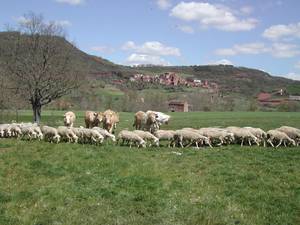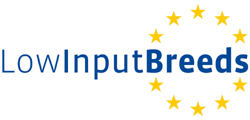Subproject 2: Sheep
Improving performance, animal health, welfare and product quality in organic and ‘low input’ SHEEP production systems
Responsible
Work packages
- WP2.1 Development of WITHIN BREED SELECTION systems to improve abiotic and biotic stress resistance and performance traits; comparing marker assisted and traditional quantitative-genetic selection systems for functional traits.
- WP2.2 Development of improved endoparasite MANAGEMENT STRATEGIES based on integrating (a) feed supplementation with tanniniferous forages with (b) strategic use of clean pastures and/or (c) the use of parasite tolerant breeds.
- WP2.3 Development of strategies to improve lamb meat quality based on optimising (a) TF feed supplements (b) grazing regimes and/or (c) the use of stress tolerant breeds
Dairy and meat sheep production systems (subproject 2)
The aim of subproject 2 is to improve the performance, animal health & welfare, and product quality in organic and ‘low input’ SHEEP production systems. The work is organised in three work packages. It will also focus on sheep breeding in Mediterranean or Alpine mountainous conditions.
Main issues
The main issues addressed under subproject 2 'sheep production systems' are:
1. Abiotic stress factors
Extreme temperatures and imbalanced diets are known to result in significant reductions in productivity and product quality in extensive small ruminant production systems. Heat stress is increasingly recognised as a major problem and predicted changes in climate are expected to increase heat stress incidence, especially in Southern Europe.
On the other hand, cold stress is expected to remain an important issue in Northern and North Eastern Europe and in mountainous/alpine regions. Abiotic stress and the related consequences on the disruption of feed intake are also known to increase the susceptibility of sheep to intestinal parasites and mastitis.
Intensification of sheep production has usually focused on (a) minimising the impact of environmental stress by introduction of housing systems (especially for dairy sheep or goats), (b) supplementary concentrate feeding, and (c) the use of hormones to be independent of seasonal lambing pattern. However, these practices increase input costs and the use of unnecessary housing and hormones is discouraged/prohibited under organic farming standards.
2. Biotic stress factors
Parasites remain one of the most important animal health and welfare problems in both ‘low input’ meat and dairy sheep production. In dairy systems pathogens causing mastitis also provoke significant economic losses. These problems are currently mainly controlled by regular anthelmintic and antibiotic treatment, a practice which may result in (a) anthelmintic and antibiotic resistance in parasite/pathogen populations (b) loss of consumer confidence in health and welfare practices in ‘low input’ systems and (c) consumer concerns about residues of antibiotics / anthelmintics in meat and dairy products.
3. Meat and milk quality
A range of quality characteristics are increasingly demanded by consumers, on meat and milk quality parameters in small ruminants. This includes (a) nutritional quality parameters, (b) sensory, but also (c) environmental and ethical qualities and (d) reduced residue risk from lower reliance on agrochemical/veterinary medicine use.
However, different to cattle, pig and poultry production, relatively little is known about effects of genotype/breed and ‘low input’ production practices on the food quality parameters in sheep and goat systems.
4. Lack of R&D support for Mediterranean and mountainous/alpine regions of Europe.
Most recent research to improve organic and ‘low input’ small ruminant production focused on Northern maritime, Scandinavian and Central European production systems. For example, ‘robustness’ traits (e.g. scrapie, parasite and foot rot resistance) have been successfully introduced into Northern European sheep populations either by selection of resistant lines within large population breeds or by cross-breeding after characterisation of the genetic background of the different breeds. Also, the only large EU project (WORMCOPS ![]() ), which focused on developing integrated parasite management systems for orga-nic and ‘low input’ systems, was mainly dedicated to Northern European systems.
), which focused on developing integrated parasite management systems for orga-nic and ‘low input’ systems, was mainly dedicated to Northern European systems.
Innovations developed for Northern Europe may be difficult to apply in other European regions, because of differences (a) in husbandry, feeding and management regimes, (b) climatic conditions and associated differences in the epidemiology of parasites/pathogens and (c) genetics of breeds used (e.g many breeds used Northern Europe were bred for meat production, while dairy and/or dual purpose (milk/meat) breeds dominate in many Mediterranean regions).
In addition, some breeding approaches to enhance genetic resistance to parasites/pathogens appear less desirable in Mediterranean or mountainous/alpine regions.
Acivities under subproject 2
 |
The programme of activities proposed under subproject 2 will therefore focus on improving (a) abiotic and biotic stress resistance, (b) animal health and welfare, and (c) product quality in dairy and meat sheep production systems in the Mediterranean and mountainous/alpine regions of Europe.
In particular, the subproject will aim to develop integrated strategies, combining within breed selection strategies for biotic and abiotic stress tolerance with innovative outdoor management strategies to control endoparasites and improve meat and milk quality.
These strategies are also relevant and may subsequently be applied to Northern and Eastern European sheep and goat production systems, including those found in the Balkan countries.
Work under subproject 3 is subdivided into three main workpackages focussing on:
- Development of WITHIN BREED SELECTION systems to improve abiotic and biotic stress resistance and performance traits; comparing marker assisted and traditional quantitative-genetic selection systems for functional traits.
- Development of improved endoparasite MANAGEMENT STRATEGIES based on integrating (a) feed supplementation with tanniniferous forages with (b) strategic use of clean pastures and/or (c) the use of parasite tolerant breeds.
- Development of strategies to improve lamb meat quality based on optimising (a) TF feed supplements (b) grazing regimes and/or (c) the use of stress tolerant breeds.
 This website was archived on December 19, 2017 and is no longer updated.
This website was archived on December 19, 2017 and is no longer updated.


